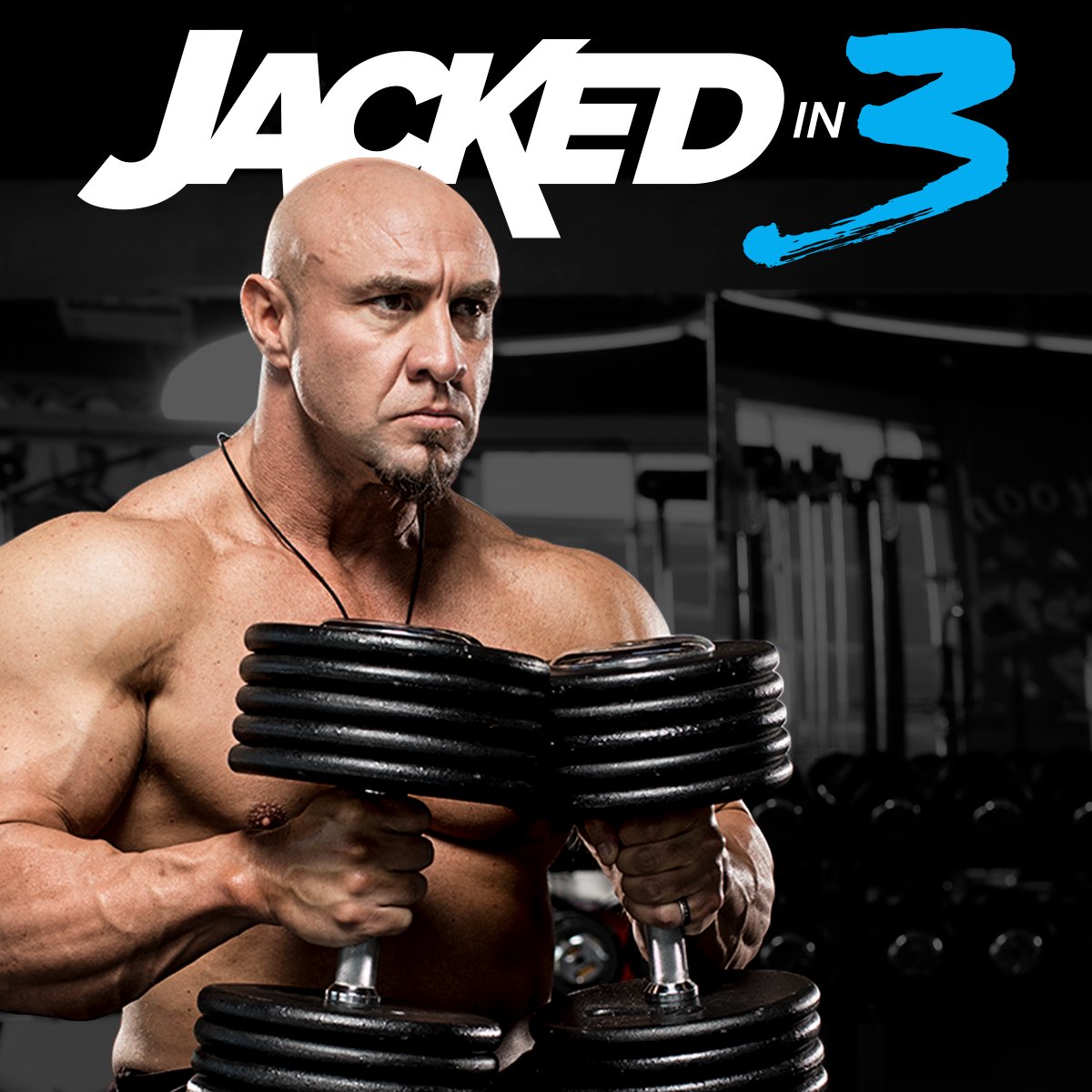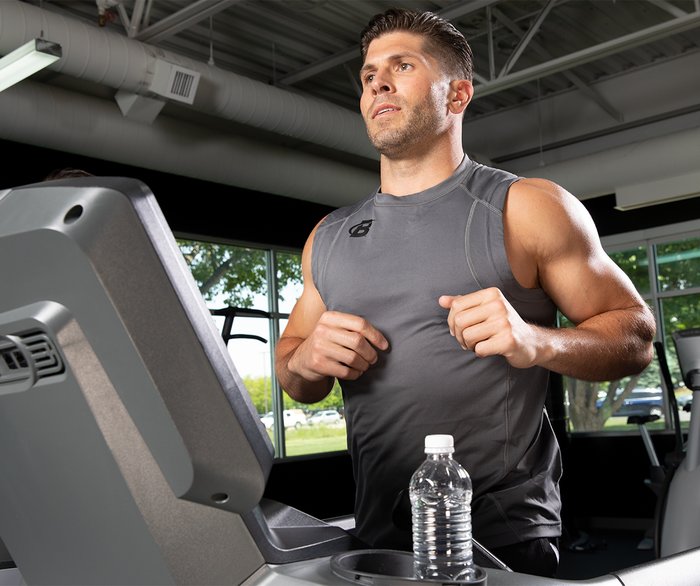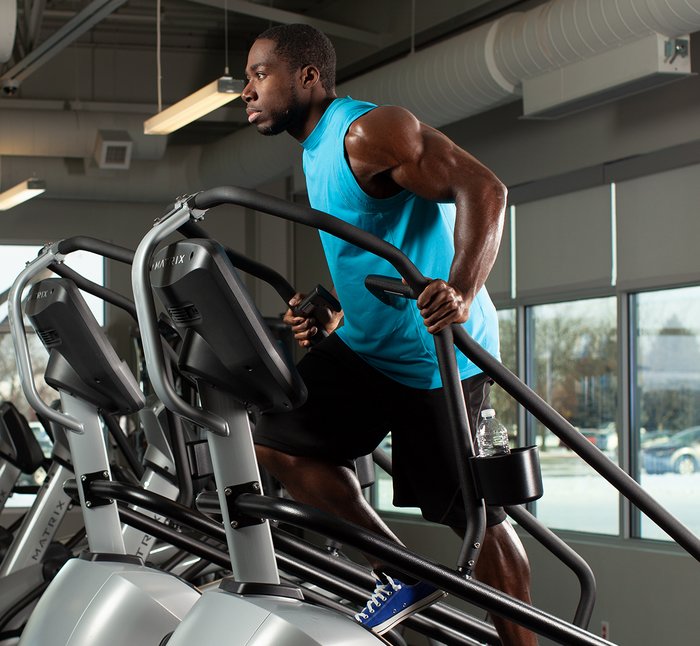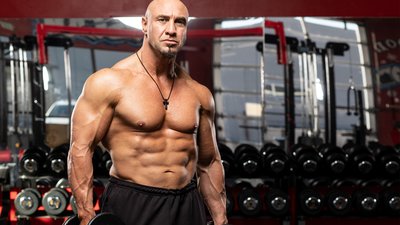Most people are using cardio for a single goal: fat-loss. And as a fat-loss tool, most cardio is pretty lame.
That's why you won't find the word "cardio" in my Bodybuilding.com BodyFit Elite program Jacked in 3. Instead, I talk about conditioning.
What's the difference? It starts with the mindset: Lose the fat-loss fixation, and instead focus on doing things that make your strength training more effective. Here's what you need to know.
Why You Need to Ditch "Cardio" and Embrace "Conditioning"
That hour you spent on the treadmill, depending on your weight and the speed at which you walked, might burn 300 or so calories. That muffin you rewarded yourself with afterward for your amazing fitness stewardship, has 600 calories.
One takeaway, of course, is there's really no point in doing the cardio if you're not going to fix your nutrition first.
But what about some really badass high intensity cardio—the Navy SEAL shit with ropes and fan bikes? Doesn't that burn a metric buttload of calories not only during, but after the session is over?
You're talking about excess post-exercise oxygen consumption, or EPOC. Some also refer to this as the "afterburn." It's one of the reasons that so many fitness gurus hail interval training as superior to low intensity steady state cardio.
There's just one problem with this: The calories burned in the EPOC state actually don't amount to a whole lot. For example, that 15 minutes of interval training you did on the stationary bike might have burned 120 calories. The EPOC value of that might be around 14 percent, netting you another 16 calories burned after the interval session. Whoopee.
A half-hour of low-intensity work on the treadmill netted you a 150-calorie loss, with another 7 calories burned after. In other words, about the same or slightly more than the high-intensity session.
The other problem with high-intensity training is that it's far more recovery intensive than low-intensity work, which actually has restorative qualities and can help with recovery. High-intensity cardio work should be seen as another lifting session, and not "cardio." But if muscle gain is the goal, it's still pretty weak compared to actual lifting.
One more problem with doing lots of cardio? The energy expenditure from it will often increase your appetite, making it harder to use your most powerful weapon in the fat-loss arsenal: adhering to your diet.
"Wow, you're really doing some case building against cardio, aren't you?" Not at all. I'm trying to get you to see that if you want to lose that whale blubber you accumulated and end up with a leaner and more muscular physique, then you need to...
- Fix your diet first.
- Focus on lifting hard for muscle retention.
- Use conditioning work appropriately.
See that word there? Conditioning. It's not cardio. It's a slightly different tool that you use to improve recovery and improve the quality of the time you spend in the gym. It doesn't just burn calories, it makes you better at doing the stuff that really matters, like strength training, recovering adequately, and fitting more overall activity into your life.
But it requires a bit of a mental shift to make it work, and most people will do it wrong if left to their own devices (no offense). So, I'm going to lay out a four-week progression to help you get the most out of it. If you're following Jacked in 3, do Phase 1 the first time through the program—or your current time—and then the second phase in your next go-round.

Phase 1: Low-Intensity Work For 4 Weeks
Here's the thing: The majority of your conditioning should actually be low-intensity, steady-state work. After all the hate I heaped on cardio earlier, you may be surprised about that. Don't be. Remember, the difference is in the goal, which is making you a better lifter, not just logging hours in the name of fat-loss.
The cornerstones here of body composition improvement, as well as performance improvement, is a high degree of muscle retention while the fat is burned off. Conditioning—I'll be straight about it—doesn't build muscle.
Some finger-wagger can probably point to a study showing some modicum of muscle gain with high-intensity cardio, but let's be reasonable: Even high-intensity work does nothing close to the magnitude of muscle-building that clanging and banging the weights does.
But on the flipside, the centerpiece of lifting is actually recovery. After all, if you can't recover from training, then your training will be inefficient and often catabolic. Lifting weights actually breaks down muscle, in case you didn't know.
Low-intensity work like walking at a leisurely pace for half an hour has restorative effects and does a great job at chipping away at body fat without touching your muscle. You heard me. For anyone who has ever bought into the nonsense that low-intensity work will eat through muscle, we're talking 30 minutes here. Not hours on end. If you're losing muscle because of a 30-minute easy-paced walk then you should check in with a medical professional immediately because you have bigger problems that need to be addressed.

The other thing about stuff like walking is that it serves as necessary preparation for doing high-intensity work if you've been a sloth for months on end. Before you start with your Usain Bolt impersonations on the track, it's a decent idea to actually build up to that with a few weeks of low-intensity work in a preparatory phase.
So, here's your assignment: Four weeks of just hitting the pavement or treadmill at a nice brisk pace that can be sustained for 30 minutes. If it's on the treadmill I'd suggest something in the 3.2-3.6 MPH range, or anything that keeps your heart rate at around 130 beats per minute.
Do this 3-4 times a week for 30 minutes, at whatever time works for you. Morning, evening, post-workout—they're all fine. Yes, it's still boring, but you should find that your recovery from your lifting sessions improves both in and out of the gym from this.
Phase 2: High-Intensity and Low-Intensity Work For 4 Weeks
Interval training is everyone's favorite form of fat-loss work, and the reason why is no secret: It's not overly boring, and it's fairly efficient at fat burning even in short bouts.
But as I mentioned earlier, it also has a greater impact on both systemic and localized recovery. A hard day of sprints can leave you with some heavy legs and a bit lethargic the day after. This is why interval training should not be the cornerstone of your conditioning work.
Instead, think of it as a supplement to the conditioning supplement. My general rule for intervals is that for every high-intensity session done, there should be at least 2-3 low-intensity sessions done in the same week. And I recommend that high-intensity work should always be done after leg day.
I just heard your mental record scratch. "Why would you do it after leg day? Wouldn't that hamper recovery even more?"
I learned years ago from a great strength coach that worked with NFL players that he always had their hardest lifting session the day after the game. Why? Because game day was hard, and it made more sense to have the hardest lifting done the day after the game, so that the rest of the week could be geared toward recovery for the next game.
With high-intensity work, approach it with the same mentality. Leg day is your game day. High-intensity work should be done the day after so the rest of the week isn't as impacting on overall recovery.

If you're running the Jacked in 3 program, which alternates weeks with one and two leg days, this means one week you would do a high-intensity interval session once, and the following week a high-intensity interval session twice.
The low-intensity work never goes away, mind you. It's still done on the days you're not lifting and not doing the interval work.
Here's a simple way to set it up, after you have your four-week phase of low-intensity conditioning out of the way:
Week 1
- Day 1: Upper-body lifting
- Day 2: Low-intensity conditioning: 30 min. steady state
- Day 3: Lower-body lifting
- Day 4: High-intensity conditioning
- Day 5: Upper-body lifting
- Day 6 and 7: Low-intensity conditioning: 30 min. steady state
Week 2
- Day 1: Lower-body lifting
- Day 2: High-intensity conditioning
- Day 3: Upper-body lifting
- Day 4: Low-intensity conditioning: 30 min. steady state
- Day 5: Lower-body lifting
- Day 6: High-intensity conditioning
- Day 7: Low-intensity conditioning: 30 min. steady state
Week 3
- Repeat the schedule starting from Week 1
But what do I do?
There are plenty of ways to implement high-intensity conditioning work. Personally, I have two preferred methods.
One is good ol' sprints. The second is using the stationary bike. If you have another method you prefer, that's cool. I would just make sure there are a few principles you use regardless of what your method is:
1. Use a warm-up. A quick 10 minutes of warming up is mandatory. You don't want to bust out in a full-bore sprint without some type of warm-up. That's a bad time waiting to happen for your hamstrings.
2. Use a cool-down. Interval training is awesome at mobilizing fat, but just because it's in the bloodstream doesn't mean it gets used for energy. Low-intensity work sucks for mobilizing fat, but it does a great job of actually using the fat already in the bloodstream for energy. With a 10-minute cool-down, you get a chance to burn the mobilized fat from the interval training.
Yes, this means that even your badass intervals are sandwiched between two 10-minute boring steady-state sessions, but they serve an important purpose. Don't neglect them.

If you're going to use the stationary bike here is my recommended protocol:
- 10-minute warm-up at an easy pace
- 15 seconds all out, followed by 45 seconds at an easy pace
Repeat this 12-15 times, depending on your level of conditioning when you start this phase. Then have a 10-minute cool-down afterward.
If you're going to do sprints, here's my favorite protocol:
- 10-minute walk beforehand
- 40-yard sprints performed at 70-75 percent of full speed. Not 100 percent.
"Rest" is a slow walk back of the 40 yards. Don't rush this part. Then repeat 10-12 times. Over the month, work up to 20 40-yard sprints if possible. And always have your 10-minute cool-down afterward.
Remember the purpose of the intervals. It's to increase your conditioning so that the gym work is easier, which then allows you to train harder with less rest time between sets. The increase in energy deficit and fat-loss is just a byproduct. Yes, you'll get leaner from the conditioning work, but use it to make your training time in the gym more awesome and beastly, and you'll get all the body composition changes you want, and more.


